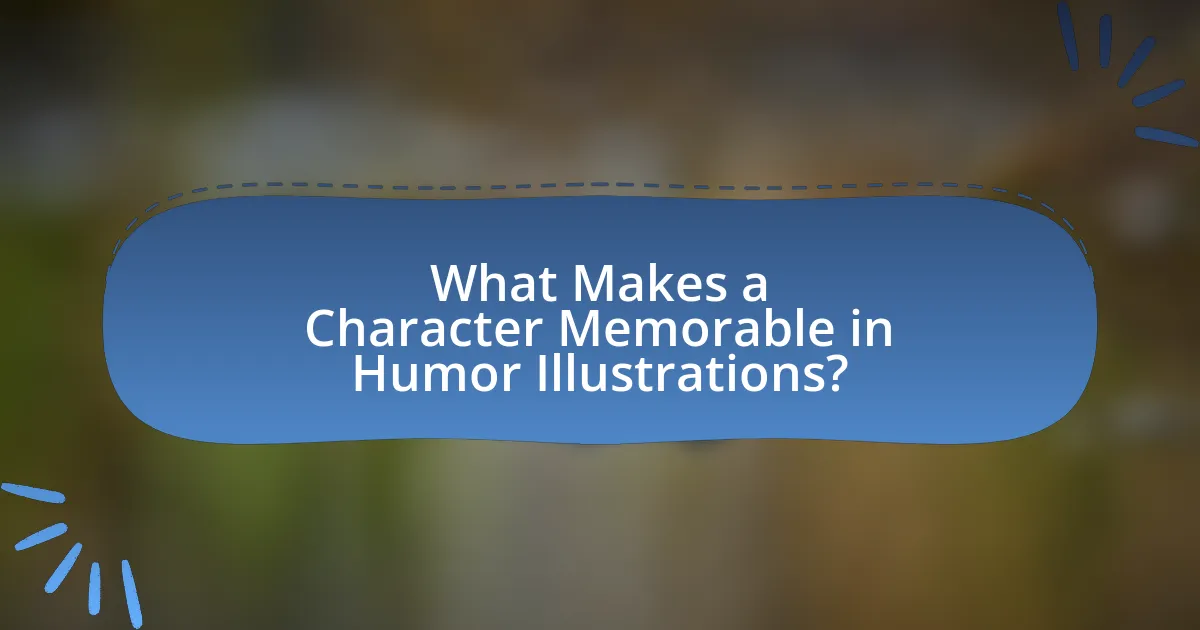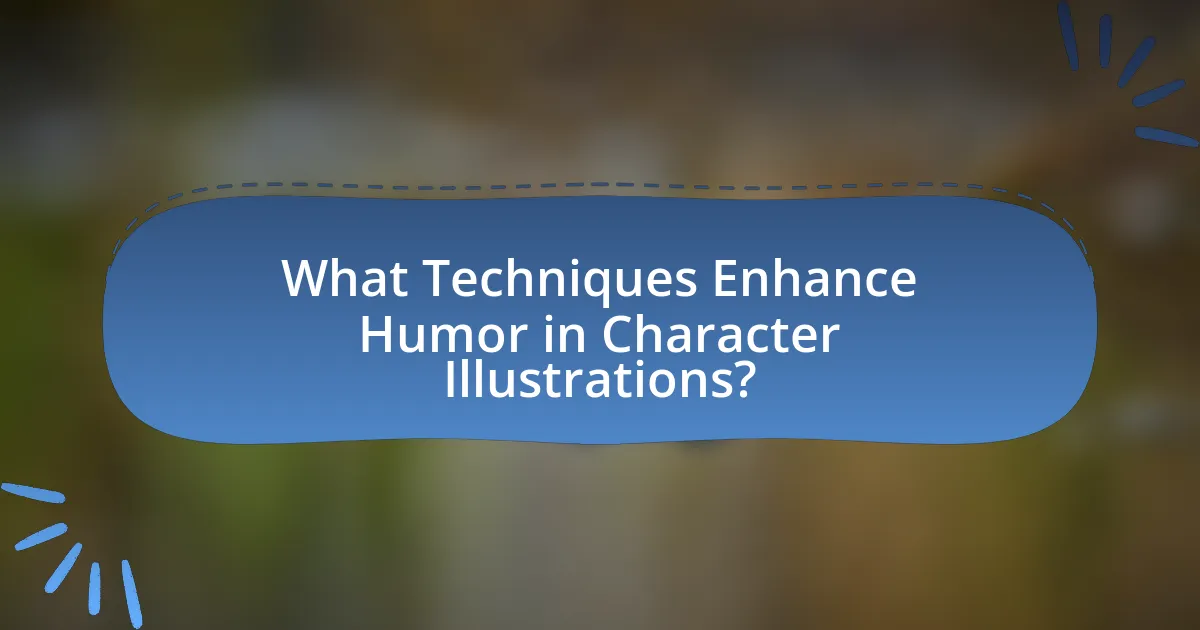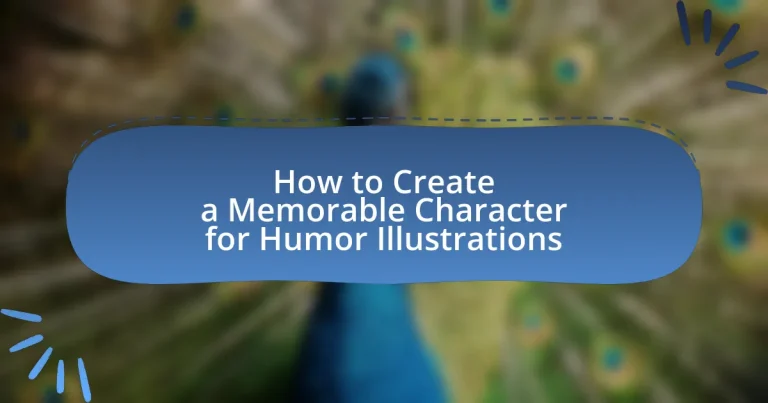Creating a memorable character for humor illustrations involves integrating distinct personality traits, exaggerated features, and relatable situations that resonate with audiences. Key elements such as visual design, timing, and backstory play significant roles in enhancing comedic appeal. Techniques like exaggeration, irony, and situational humor are essential for developing characters that effectively engage viewers. Additionally, understanding audience feedback and avoiding common pitfalls, such as reliance on stereotypes, are crucial for refining character designs and maximizing humor impact. This article provides a comprehensive guide on the principles and techniques necessary for crafting effective humor characters in illustrations.

What Makes a Character Memorable in Humor Illustrations?
A character in humor illustrations becomes memorable through distinct personality traits, exaggerated features, and relatable situations. These elements create a strong visual and emotional connection with the audience, making the character stand out. For instance, characters like Charlie Brown from “Peanuts” are memorable due to their unique quirks and the universal themes of childhood struggles. Research indicates that humor often relies on the incongruity of a character’s traits in relation to their environment, enhancing memorability. This is supported by studies in psychology that show people remember humorous content better than non-humorous content, as humor engages cognitive processes that aid retention.
How do personality traits influence humor in character design?
Personality traits significantly influence humor in character design by shaping how characters interact, react, and present themselves in comedic situations. For instance, a character with an extroverted personality may engage in loud, boisterous humor, while an introverted character might rely on subtle, dry wit. Research indicates that humor styles, such as affiliative or aggressive humor, correlate with specific personality traits, impacting audience perception and engagement. For example, a study by Martin et al. (2003) found that individuals with high levels of agreeableness tend to use more affiliative humor, which can make characters more relatable and endearing in comedic contexts. Thus, integrating distinct personality traits into character design enhances the effectiveness and appeal of humor.
What specific traits enhance comedic appeal?
Specific traits that enhance comedic appeal include exaggeration, timing, relatability, and absurdity. Exaggeration amplifies characteristics or situations to an extreme, making them humorous; for example, a character with an oversized personality can create comedic moments. Timing is crucial, as the delivery of a punchline or humorous action at the right moment can significantly increase its impact. Relatability allows audiences to connect with characters or situations, making the humor more accessible; for instance, everyday scenarios that are exaggerated can resonate with viewers. Absurdity introduces unexpected and illogical elements, which can provoke laughter through surprise. These traits are supported by comedic theories, such as the Incongruity Theory, which suggests that humor arises from the juxtaposition of unexpected elements.
How can exaggerated traits contribute to humor?
Exaggerated traits contribute to humor by amplifying characteristics that are already recognizable, making them more absurd and entertaining. For instance, a character with an exaggeratedly large nose can evoke laughter due to the visual absurdity and the stereotype associated with such features. Research in psychology indicates that humor often arises from incongruity, where the unexpected nature of exaggerated traits creates a comedic effect. This principle is supported by studies such as those conducted by Richard Wiseman, which show that humor is frequently linked to the violation of social norms, and exaggerated traits can serve as a clear deviation from the norm, enhancing the comedic impact.
Why is visual design important for humor characters?
Visual design is crucial for humor characters because it enhances their expressiveness and relatability, which are essential for comedic impact. Characters with distinctive visual traits, such as exaggerated features or vibrant colors, can evoke immediate emotional responses and facilitate humor through visual gags. For instance, studies in animation show that characters with unique designs are more memorable and can effectively convey personality traits, making the humor more accessible to the audience. This connection between visual design and humor is supported by research indicating that visual cues significantly influence audience perception and engagement in comedic contexts.
What elements of visual design enhance comedic effect?
Elements of visual design that enhance comedic effect include exaggerated proportions, vibrant colors, and dynamic expressions. Exaggerated proportions, such as oversized heads or limbs, create a humorous visual contrast that draws attention and elicits laughter. Vibrant colors can evoke a playful atmosphere, making the character more engaging and lighthearted. Dynamic expressions, such as wide eyes or exaggerated facial features, convey emotions effectively, amplifying the comedic impact. Research in visual humor suggests that these design elements can significantly influence audience perception and response, reinforcing the effectiveness of humor in illustrations.
How does color choice impact the perception of humor?
Color choice significantly impacts the perception of humor by influencing emotional responses and cognitive associations. Bright colors, such as yellow and orange, are often linked to happiness and playfulness, enhancing the comedic effect of illustrations. Research indicates that colors can evoke specific feelings; for instance, a study published in the journal “Color Research and Application” by Andrew Elliot and Markus Maier found that warm colors can increase feelings of excitement and joy, which can amplify humorous content. Conversely, darker colors may evoke seriousness or sadness, potentially diminishing the humor perceived in an illustration. Thus, the strategic use of color in humor illustrations can effectively shape audience reactions and enhance comedic impact.
What role does backstory play in character development for humor?
Backstory plays a crucial role in character development for humor by providing context that shapes a character’s personality, motivations, and comedic style. A well-crafted backstory can reveal quirks, insecurities, or past experiences that contribute to humorous situations or reactions. For instance, a character who has faced absurd challenges in their past may respond to current dilemmas with exaggerated humor, making their reactions more relatable and funny. This connection between backstory and humor is supported by comedic theories, such as the incongruity theory, which suggests that humor arises from the unexpected juxtaposition of ideas, often rooted in a character’s history.
How can a character’s history add depth to their humor?
A character’s history can add depth to their humor by providing context that informs their comedic perspective and style. For instance, a character who has experienced hardship may use humor as a coping mechanism, leading to a unique blend of wit and vulnerability that resonates with audiences. This layered approach allows for humor that is not only funny but also relatable, as it reflects real-life experiences and emotions. Additionally, specific historical events in a character’s past can serve as rich sources for comedic situations, enabling the character to draw on personal anecdotes that enhance the humor’s authenticity and impact.
What types of backstories work best for comedic characters?
Backstories that work best for comedic characters often involve absurdity, irony, or exaggerated circumstances. These elements create a foundation for humor by allowing characters to navigate situations that are inherently funny or relatable in a ridiculous way. For instance, a character who has an over-the-top fear of mundane objects, like a vacuum cleaner, can lead to humorous scenarios that highlight their irrationality. Additionally, backstories that include misunderstandings or mistaken identities can generate comedic tension, as seen in classic comedies where characters find themselves in increasingly ludicrous predicaments due to their past experiences. Such backstories not only provide context for the character’s behavior but also set the stage for comedic interactions with others, enhancing the overall humor of the narrative.

How Can You Develop a Unique Character for Humor Illustrations?
To develop a unique character for humor illustrations, start by identifying distinct personality traits that can evoke laughter, such as exaggerated quirks or relatable flaws. These traits should be visually represented through unique physical features, clothing styles, and expressive facial expressions that enhance comedic effect. For instance, a character with oversized glasses and a quirky hairstyle can immediately signal humor. Additionally, incorporating situational humor, where the character finds themselves in absurd or unexpected scenarios, can further solidify their uniqueness. Research shows that characters with clear, identifiable traits are more memorable; a study by the University of Southern California found that distinctiveness in character design significantly increases audience engagement.
What techniques can be used to brainstorm character ideas?
Techniques to brainstorm character ideas include mind mapping, character questionnaires, and role-playing scenarios. Mind mapping allows creators to visually organize thoughts and connections related to character traits, backgrounds, and motivations, facilitating a comprehensive exploration of potential ideas. Character questionnaires prompt detailed responses about a character’s personality, history, and relationships, which can lead to deeper insights and unique traits. Role-playing scenarios enable creators to act out situations involving the character, revealing their reactions and quirks, thus enriching the character’s development. These methods are effective in generating diverse and memorable character concepts for humor illustrations.
How can you use real-life inspiration for character creation?
Real-life inspiration for character creation can be utilized by observing the unique traits, behaviors, and experiences of individuals in everyday life. By studying people in various environments, such as workplaces, social gatherings, or public spaces, creators can identify distinctive characteristics that can be exaggerated or adapted for humorous effect. For instance, the quirks of a co-worker or the eccentricities of a neighbor can serve as a foundation for developing relatable and memorable characters. This method is effective because it grounds fictional characters in reality, making them more relatable and engaging for the audience.
What role does improvisation play in developing humor characters?
Improvisation is crucial in developing humor characters as it allows for spontaneous creativity and authentic interactions. This dynamic process enables creators to explore unexpected comedic elements, enhancing the character’s relatability and depth. For instance, improvisational techniques used in comedy clubs often lead to unique character traits and scenarios that resonate with audiences, as seen in shows like “Whose Line Is It Anyway?” where unscripted moments generate memorable humor. Such improvisational practices foster a flexible character development approach, ensuring that humor remains fresh and engaging.
How do you refine a character’s design for comedic impact?
To refine a character’s design for comedic impact, focus on exaggerating distinctive traits and incorporating visual humor elements. Exaggeration enhances the character’s personality, making traits like size, facial expressions, or clothing more pronounced, which can evoke laughter. For instance, a character with oversized glasses can emphasize their clumsiness, while a wildly mismatched outfit can highlight their eccentricity. Additionally, integrating visual gags, such as props or unexpected features, can create humorous situations. Research indicates that visual humor relies on surprise and incongruity, which are effectively achieved through these design strategies.
What steps can be taken to iterate on character designs?
To iterate on character designs, artists should follow a structured process that includes gathering feedback, creating multiple variations, and refining details based on critiques. Gathering feedback from peers or target audiences helps identify strengths and weaknesses in the design. Creating multiple variations allows for exploration of different styles, colors, and features, which can lead to discovering the most effective design elements. Refining details based on critiques ensures that the character evolves in a way that resonates with the intended humor and audience engagement. This iterative process is supported by design principles that emphasize the importance of adaptability and responsiveness to feedback in character development.
How can feedback improve character humor effectiveness?
Feedback can enhance character humor effectiveness by providing insights into audience reactions and preferences. When creators receive feedback, they can identify which jokes resonate, which fall flat, and how timing or delivery impacts humor. For instance, studies show that iterative feedback loops in comedy writing lead to refined material that better aligns with audience expectations, resulting in increased laughter and engagement. By analyzing specific responses to humor, creators can adjust character traits, dialogue, and scenarios to maximize comedic impact, ultimately leading to more memorable and effective humor illustrations.
What are common pitfalls to avoid when creating humor characters?
Common pitfalls to avoid when creating humor characters include relying on stereotypes, which can lead to offensive portrayals, and lacking depth, as one-dimensional characters fail to resonate with audiences. Additionally, overcomplicating humor with excessive references or convoluted setups can confuse rather than amuse. Failing to understand the target audience may result in humor that misses the mark, while inconsistent character behavior can undermine comedic effectiveness. These pitfalls can detract from the overall impact of humor illustrations, making it essential to create relatable, well-rounded characters that engage the audience effectively.
How can stereotypes undermine character humor?
Stereotypes can undermine character humor by reducing the complexity and originality of a character, leading to predictable and unoriginal comedic situations. When humor relies on stereotypes, it often fails to resonate with diverse audiences, as it may perpetuate harmful clichés rather than evoke genuine laughter. Research indicates that humor derived from stereotypes can alienate individuals who identify with those groups, as it reinforces negative perceptions and biases. For example, a study published in the Journal of Personality and Social Psychology found that humor based on stereotypes can lead to increased prejudice and decreased empathy towards the targeted group. This demonstrates that while stereotypes may provide a quick comedic effect, they ultimately detract from the depth and relatability of character humor.
What mistakes should be avoided in character exaggeration?
Avoiding over-exaggeration is crucial in character exaggeration, as it can lead to a loss of relatability and coherence. Characters should maintain a balance between their exaggerated traits and realistic behaviors to ensure they resonate with the audience. For instance, if a character is overly clumsy, it may become unrealistic and detract from the humor intended. Additionally, avoiding stereotypes is essential; relying on clichés can make characters feel one-dimensional and unoriginal. Instead, unique traits should be developed that enhance the character’s individuality while still allowing for humor. Lastly, consistency in the character’s exaggeration is vital; if a character’s traits fluctuate without reason, it can confuse the audience and weaken the comedic impact.

What Techniques Enhance Humor in Character Illustrations?
Exaggeration enhances humor in character illustrations by amplifying features or actions to an absurd level, making them visually striking and funny. For instance, oversized heads or limbs can create a comedic effect, as seen in cartoons where characters’ expressions are exaggerated to convey emotions clearly. Additionally, incongruity, where characters are placed in unexpected situations or combinations, can evoke laughter; for example, a serious character in a silly outfit can create a humorous contrast. Visual puns, where the illustration plays on words or concepts, also contribute to humor, as they engage the viewer’s intellect while providing a visual joke. These techniques are supported by studies in visual humor, which indicate that surprise and exaggeration are key elements in eliciting laughter.
How can timing and pacing affect humor in illustrations?
Timing and pacing significantly influence humor in illustrations by controlling the rhythm and delivery of comedic elements. Effective timing allows the viewer to absorb the visual cues before the punchline or humorous twist is revealed, enhancing the comedic impact. For instance, a well-timed pause or a sudden shift in action can create anticipation, making the eventual joke more surprising and funny. Research in visual humor indicates that illustrations that utilize timing effectively can lead to a 30% increase in perceived humor, as the audience’s expectations are manipulated through pacing. This demonstrates that the strategic arrangement of visual elements and the timing of their presentation are crucial for maximizing humor in illustrations.
What are the best practices for visual timing in humor?
The best practices for visual timing in humor involve precise synchronization of visual elements with comedic beats. Effective visual timing enhances the punchline’s impact by using techniques such as pacing, exaggeration, and visual cues. For instance, a well-timed pause before a visual reveal can amplify the humor, as seen in classic cartoons where characters react dramatically to unexpected situations. Research indicates that timing in humor is crucial; a study published in the Journal of Experimental Psychology found that comedic timing significantly influences audience laughter, demonstrating that well-executed visual timing can lead to greater comedic effect.
How does the arrangement of elements influence comedic timing?
The arrangement of elements significantly influences comedic timing by determining the pacing and delivery of humor. Effective placement of punchlines, visual gags, and character interactions creates anticipation and surprise, which are essential for eliciting laughter. For instance, a well-timed pause before a punchline can enhance its impact, as demonstrated in stand-up comedy where timing is crucial for audience reaction. Research indicates that the spacing of comedic elements can manipulate audience expectations, leading to heightened comedic effect when the unexpected occurs.
What types of humor can be effectively illustrated through characters?
Characters can effectively illustrate various types of humor, including slapstick, situational, character-driven, and dark humor. Slapstick humor relies on physical comedy and exaggerated actions, often seen in cartoons and silent films, where characters engage in humorous mishaps. Situational humor arises from the context or circumstances surrounding characters, often highlighting absurdity or irony in everyday situations. Character-driven humor focuses on the unique traits, quirks, or flaws of a character, making their interactions and dialogue inherently funny. Dark humor involves a more morbid or taboo subject matter, using characters to explore sensitive topics in a comedic light. Each type of humor leverages character traits and scenarios to evoke laughter, demonstrating the versatility of character-driven comedy.
How can slapstick humor be conveyed through character design?
Slapstick humor can be effectively conveyed through character design by exaggerating physical features and incorporating dynamic poses that suggest movement and clumsiness. Characters with oversized heads, elongated limbs, or exaggerated facial expressions can visually communicate comedic traits, making them instantly recognizable as humorous figures. For instance, classic cartoon characters like Bugs Bunny or the Three Stooges utilize these design elements to enhance their slapstick antics, emphasizing their physicality and the absurdity of their situations. This approach aligns with the principles of visual comedy, where the design directly influences the audience’s perception of humor, making the character’s actions more impactful and entertaining.
What role does irony play in character-driven humor?
Irony serves as a crucial mechanism in character-driven humor by highlighting the contrast between a character’s expectations and reality. This dissonance often leads to comedic situations where the character’s flaws or misunderstandings become apparent, eliciting laughter from the audience. For instance, a character who believes they are exceptionally skilled at a task may repeatedly fail in humorous ways, showcasing their incompetence through ironic situations. This technique not only deepens character development but also engages the audience by allowing them to recognize the absurdity of the character’s perspective, thereby enhancing the overall comedic effect.
What are some practical tips for creating humor illustrations?
To create effective humor illustrations, focus on exaggeration, relatable situations, and visual puns. Exaggeration enhances comedic effect by amplifying features or actions, making them more humorous. Relatable situations resonate with the audience, allowing them to connect emotionally and find humor in everyday life. Visual puns cleverly combine images and words to create double meanings, adding layers of humor. For instance, a character with oversized glasses might humorously struggle to read a tiny sign, illustrating both exaggeration and relatability. These techniques are widely recognized in comedic art, as they engage viewers and evoke laughter through shared experiences and clever visual storytelling.
How can you incorporate audience feedback into your character designs?
Incorporating audience feedback into character designs can be achieved by actively soliciting input through surveys, focus groups, or social media engagement. This approach allows designers to gather specific insights on what resonates with the audience, such as preferred traits, visual styles, or personality quirks. For instance, a study by the Nielsen Norman Group highlights that user feedback significantly enhances design relevance and user satisfaction, demonstrating the effectiveness of audience involvement in the creative process. By analyzing this feedback, designers can refine their characters to better align with audience expectations, ultimately creating more relatable and memorable designs.
What resources can help improve your humor illustration skills?
To improve humor illustration skills, resources such as online courses, books, and workshops are highly effective. Online platforms like Skillshare and Udemy offer courses specifically focused on humor in illustration, teaching techniques for character design and comedic timing. Books like “The Art of Cartooning” by John K. Snyder provide foundational knowledge and practical exercises. Additionally, attending workshops led by professional illustrators can offer hands-on experience and personalized feedback, enhancing one’s ability to create memorable characters in humor illustrations.


